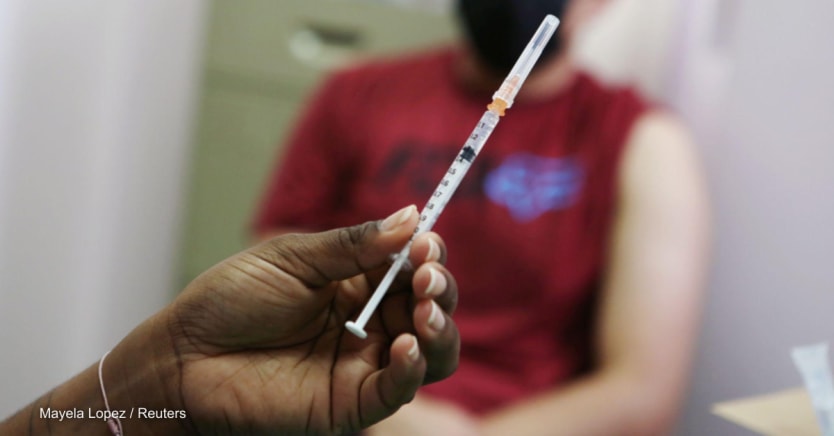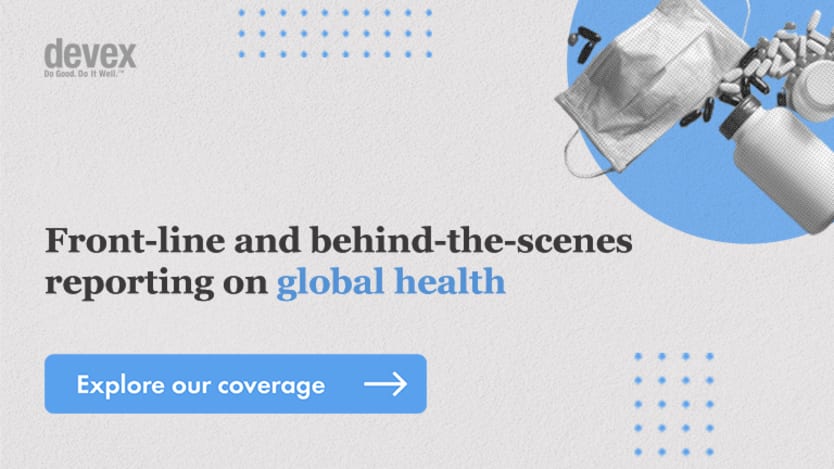
The World Health Organization has issued a warning over a looming syringe shortage that could threaten the already struggling efforts to vaccinate populations across the African continent for COVID-19.
Sign up for Devex CheckUp
The must-read weekly newsletter for exclusive global health news and insider insights.
“There is a looming threat that syringe supplies will dry up,” said Dr. Matshidiso Moeti, the World Health Organization’s regional director for Africa, during a press briefing Thursday. “Unless drastic measures are taken to boost syringe production, Africa faces a crisis.”
UNICEF estimates a shortfall of up to 2.2 billion auto-disable syringes, which automatically lock after use to prevent reuse, next year. This type of syringe is disproportionately used in low- and middle-income countries.
The shortage hasn’t yet hit countries in a severe way. Most countries have received syringes bundled with shipments of COVID-19 vaccines from COVAX and UNICEF. But this is only because the African continent has not received large amounts of vaccines. Less than 6% of the continent’s population is vaccinated.
“This could have long lasting public health consequences way beyond 2022.”
— Sibusiso Hlatjwako, director of external affairs, PATH in Africa“This was possible at the beginning, because we had fewer numbers of doses, but now with the doses coming in, without a plan we shall really be in trouble,” said Dr. Phionah Atuhebwe, the new vaccine introduction officer at WHO Africa.
“The vaccine donations are now surpassing the syringe availability,” she added.
And there are already signs of what’s to come. When some high-income countries donate vaccines bilaterally, they are not including syringes, said Sibusiso Hlatjwako, director of external affairs for PATH in Africa. WHO said Kenya, Rwanda, and South Africa have already had delays in receiving syringes.
Dr. Sabin Nsanzimana, director-general at the Rwanda Biomedical Centre, said this challenge is exacerbated when his country receives donated vaccines with short shelf lives. Some vaccines are received less than a month before expiry, he said, adding that when there are delays in receiving syringes, this sends the country scrambling to vaccinate before expiry.
The Pfizer vaccine needs a specific 0.3 ml auto-disposable syringe, which is a new type of syringe, meaning there are a limited number of manufacturers that produce it and there is no global stockpile.
“While manufacturers are increasingly able to produce this new syringe, there are complications when navigating the demand for two different products that are made on the same production line,” Hlatjwako said. “It can take up to a year for a new production line to be developed.”
WHO describes the market for the type of syringes the Pfizer vaccine needs as “tight and extremely competitive.”
Tackling logistical odds stacked against COVID-19 vaccination in Africa
Health experts say logistical bottlenecks need to be tackled alongside vaccine hesitancy and access for the continent to close its wide vaccination gap.
The other type of syringe used for other COVID-19 vaccines and routine immunization are 0.5 ml syringes, and are also under extreme pressure given the scale of the COVID-19 vaccine rollouts. The 2.2 billion shortage includes both of these types of auto-disable syringes.
Experts called on the private and public sectors to ensure that syringe production is ramped up fast, comparing this global shortage to the personal protective gear shortage experienced at the onset of the pandemic. They also called for an increase in the local production of syringes in Africa. While there are a few countries that produce syringes, such as Nigeria, Zambia, and Tanzania, most of the syringes are imported from Asia and Europe, Atuhebwe said — adding that no African nations produce the syringes needed for the Pfizer vaccine.
Without an increase in production, countries will be forced to make difficult decisions on whether to vaccinate for COVID-19 or to use the syringes for other childhood immunizations.
“This could have long lasting public health consequences way beyond 2022,” Hlatjwako said.









